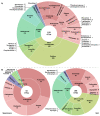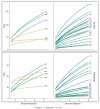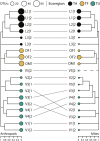Unearthing soil arthropod diversity through DNA metabarcoding
- PMID: 35178296
- PMCID: PMC8815377
- DOI: 10.7717/peerj.12845
Unearthing soil arthropod diversity through DNA metabarcoding
Abstract
DNA metabarcoding has the potential to greatly advance understanding of soil biodiversity, but this approach has seen limited application for the most abundant and species-rich group of soil fauna-the arthropods. This study begins to address this gap by comparing information on species composition recovered from metabarcoding two types of bulk samples (specimens, soil) from a temperate zone site and from bulk soil samples collected at eight sites in the Arctic. Analysis of 22 samples (3 specimen, 19 soil) revealed 410 arthropod OTUs belonging to 112 families, 25 orders, and nine classes. Studies at the temperate zone site revealed little overlap in species composition between soil and specimen samples, but more overlap at higher taxonomic levels (families, orders) and congruent patterns of α- and β-diversity. Expansion of soil analyses to the Arctic revealed locally rich, highly dissimilar, and spatially structured assemblages compatible with dispersal limited and environmentally driven assembly. The current study demonstrates that DNA metabarcoding of bulk soil enables rapid, large-scale assessments of soil arthropod diversity. However, deep sequence coverage is required to adequately capture the species present in these samples, and expansion of the DNA barcode reference library is necessary to improve taxonomic resolution of the sequences recovered through this approach.
Keywords: Arthropods; Biodiversity; Environmental DNA; Metabarcoding; NGS; Soil.
©2022 Young and Hebert.
Conflict of interest statement
The authors declare there are no competing interests.
Figures







Similar articles
-
Variations in terrestrial arthropod DNA metabarcoding methods recovers robust beta diversity but variable richness and site indicators.Sci Rep. 2019 Dec 3;9(1):18218. doi: 10.1038/s41598-019-54532-0. Sci Rep. 2019. PMID: 31796780 Free PMC article.
-
Metabarcoding for biodiversity inventory blind spots: A test case using the beetle fauna of an insular cloud forest.Mol Ecol. 2023 Dec;32(23):6130-6146. doi: 10.1111/mec.16716. Epub 2022 Oct 24. Mol Ecol. 2023. PMID: 36197789
-
Establishing arthropod community composition using metabarcoding: Surprising inconsistencies between soil samples and preservative ethanol and homogenate from Malaise trap catches.Mol Ecol Resour. 2019 Nov;19(6):1516-1530. doi: 10.1111/1755-0998.13071. Epub 2019 Sep 18. Mol Ecol Resour. 2019. PMID: 31379089 Free PMC article.
-
Metabarcoding Malaise traps and soil eDNA reveals seasonal and local arthropod diversity shifts.Sci Rep. 2021 May 18;11(1):10498. doi: 10.1038/s41598-021-89950-6. Sci Rep. 2021. PMID: 34006991 Free PMC article.
-
Connecting high-throughput biodiversity inventories: Opportunities for a site-based genomic framework for global integration and synthesis.Mol Ecol. 2021 Mar;30(5):1120-1135. doi: 10.1111/mec.15797. Epub 2021 Feb 2. Mol Ecol. 2021. PMID: 33432777 Free PMC article. Review.
Cited by
-
Hidden diversity: DNA metabarcoding reveals hyper-diverse benthic invertebrate communities.BMC Ecol Evol. 2023 May 17;23(1):19. doi: 10.1186/s12862-023-02118-w. BMC Ecol Evol. 2023. PMID: 37198575 Free PMC article.
References
-
- Anderson JM. The enigma of soil animal species diversity. In: Vaněk J, editor. Progress in soil zoology. Dordrecht: Springer Netherlands; 1975. pp. 51–58. - DOI
-
- André HM, Ducarme X, Lebrun P. Soil biodiversity: myth, reality or conning? Oikos. 2002;96(1):3–24. doi: 10.1034/j.1600-0706.2002.11216.x. - DOI
-
- André HM, Noti M-I, Lebrun P. The soil fauna: the other last biotic frontier. Biodiversity and Conservation. 1994;3(1):45–56. doi: 10.1007/BF00115332. - DOI
-
- Arribas P, Andújar C, Hopkins K, Shepherd M, Vogler AP. Metabarcoding and mitochondrial metagenomics of endogean arthropods to unveil the mesofauna of the soil. Methods in Ecology and Evolution. 2016;7(9):1071–1081. doi: 10.1111/2041-210X.12557. - DOI
Publication types
MeSH terms
Substances
LinkOut - more resources
Full Text Sources
Miscellaneous

